Practicing the CBSE Sample Papers for Class 12 Physical Education with Solutions Set 1 allows you to get rid of exam fear and be confident to appear for the exam.
CBSE Sample Papers for Class 12 Physical Education Set 2 with Solutions
Time: 3 Hours.
Max. Marks: 70
General Instructions:
- The question paper consists of 5 sections and 37 Questions.
- Section A consists of question 1-18 carrying 1 mark each and is multiple choice questions. All questions are compulsory.
- Sections B consists of questions 19-24 carrying 2 marks each and are very short answer types and should not exceed 60-90 words. Attempt any 5.
- Sections C consists of Question 25-30 carrying 3 marks each and are short answer types and should not exceed 100-150 words. Attempt any 5.
- Sections D consists of Question 31-33 carrying 4 marks each and are case studies. There is internal choice available.
- Section E consists of Question 34-37 carrying 5 marks each and are short answer types and should not exceed 200-300 words. Attempt any 3.
Section -A
Question 1.
Identify the asana: [1]
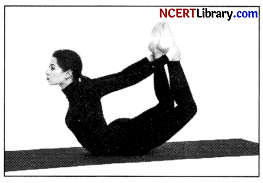
(a) Paschimottanasana
(b) Halasana
(c) Vajrasana
(d) Dhanurasana
Answer:
(d) Dhanurasana
Question 2.
A person who likes to learn new things, new concepts and new experiences are categorized as. [1]
(a) Agreeableness
(b) Extroversion
(c) Conscientiousness
(d) Openness
Answer:
(d) Openness
Question 3.
A cartwheel in gymnastics is an example of. [1]
(a) Static Equilibrium
(b) Dynamic Equilibrium
(c) Active Equilibrium
(d) Passive Equilibrium
Answer:
(b) Dynamic Equilibrium
Question 4.
Slow twitch fibers are in color.[1]
(a) White
(b) Red
(c) Transparent
(d) Brown
Answer:
(b) Red
Question 5.
Jumping on the spot is an example of_________.[1]
(a) Iso-metric
(b) Iso-tonic
(c) Iso-kinetic
(d) Iso-kinesthetic
Answer:
(b) Iso-tonic
![]()
Question 6.
Take-off in Long jump is an example of________ strength.[1]
(a) Explosive strength
(b) Maximum strength
(c) Strength endurance
(d) Static strength
Answer:
(a) Explosive strength
Question 7.
The amount of oxygen that can be absorbed and consumed by the working muscles from the blood is called. [1]
(a) Oxygen Uptake
(b) Oxygen Intake
(c) Oxygen Transport
(d) Vital capacity
Answer:
(a) Oxygen Uptake
Question 8.
In the Law of Acceleration, the acceleration of an object is inversely proportionate to its. [1]
(a) Force
(b) Mass
(c) Speed
(d) Size
Answer:
(b) Mass
Question 9.
Given below are the two statements labeled Assertion (A) and Reason (R).
Assertion (A): Intrinsic motivation has long-term benefits.
Reason (R): As factors behind it are naturally pursuing actions that provide fun, pleasure, fulfillment, or challenge
In the context of the above two statements, which one of the following is correct? [1]
(a) Both (A) and (R) are true and (R) is the correct explanation of (A).
(b) Both (A) and (R) are true, but (R) is not the correct explanation of (A).
(c) (A) is true, but (R) is false.
(d) (A) is false, but (R) is true
Answer:
(b) Both (A) and (R) are true, but (R) is not the correct explanation of (A).
Question 10.
Carbohydrates that are soluble in water and crystalline in structure.[1]
(a) Simple
(b) Complex
(c) Compound
(d) Complicated
Answer:
(a) Simple
![]()
Question 11.
Which of these is not a micromineral?.[1]
(a) Iodine
(b) Magnesium
(c) Iron
(d) Copper
Answer:
(b) Magnesium
Question 12.
Which asana is helpful in increasing height?.[1]
(a) Sukhasana
(b) Tadasana
(c) Bhujangasana
(d) Vajrasana
Answer:
(b) Tadasana
Question 13.
How many byes will be given if there are 17 teams?.[1]
(a) 1
(b) 8
(c) 15
(d) 12
Answer:
(c) 15
Question 14.
How many matches will be played in the knockout tournament’s first round if there are 15 teams? [1]
(a) 8
(b) 7
(c) 5
(d) 6
Answer:
(b) 7
Question 15.
Watching others play and enjoy which in turn motivates the Child with special needs to participate is a part of which kind of strategy?
(a) Mental
(b) Physical
(c) Psychological
(d) Social
Answer:
(d) Social
![]()
Question 16.
Match the following:
| I | Garudasana. | 1 | Round shoulder |
| II | Gomukhasana. | 2 | Lordosis |
| III | Chakrasana. | 3 | Bow legs |
| IV | Naukasana. | 4 | Knock knees |
(a) 1-3, II-4, III-l, IV-2
(b) 1-1,11-3, III-4, IV-2
(c) 1-4, II-2, III-l, IV-3
(d) 1-2, II-3, III-4, IV-1
Answer:
(a) 1-3, II-4, III-l, IV-2
Question 17.
Match the following:
| I. Chair stand test. | 1. Lower Body strength |
| II. Arm curl test. | 2. Aerobic Endurance |
| III. Back scratch test. | 3. Upper body strength |
| IV. Six minute walk test. | 4. Upper body flexibility |
(a) 1-1, II-3, III-4, IV-2
(b) 1-2, II-3, III-1, IV-4
(c) 1-1, n-3, III-2, IV-4
(d) 1-2, H-3, III-4, IV-1
Answer:
(a) 1-1, II-3, III-4, IV-2
Question 18.
Weakening of bones due to loss of bone density and improper bone formation is known as_________.[1]
(a) Amenorrhea
(b) Anorexia Nervosa
(c) Osteoporosis
(d) Lordosis
Answer:
(c) Osteoporosis
Section -B
Question 19.
List down any four effects of exercise on the muscular system. [0.5×4]
Answer:
The following are four effects of exercise on the muscular system. Short Term Effect
(i) Increase in the supply of blood
(ii) Increases muscle temperature Long-Term Effect
(i) Hypertrophy of muscle
(ii) Increase in strength of ligaments and tendons
Question 20.
List down any four benefits of self-talk by athletes in sports. [0.5×4]
Answer:
The following are four benefits of self-talk by athletes in sports
(i) Improves self esteem, stress management and well-being.
(ii) Self talk makes one feel more control in life.
(iii) It motivates to overcome obstacles.
(iv) It helps in focusing and attention.
![]()
Question 21.
List down any four advantages of the fartlek training method.[0.5×4]
Answer:
Fartlek is a Swedish term that means speed play.
Four advantages of fartlek training method are as follows:
(i) Fartlek training method is helpful in improving endurance.
(ii) It can reduce boredom as it uses different speeds, terrains, surfaces or area.
(iii) It can be applied for different sports.
(iv) It can be adjusted according to age, fitness and health of the athlete.
Question 22.
Explain any two types of soft tissue injuries with help of examples.[0.5×4]
Answer:
A soft tissue injury is defined as damage to the muscles, ligaments, or tendons throughout the body.
Two types of soft tissue injuries are as follows:
(i) Sprains: A sprain occurs when violent over-stretching of a ligament in a joint. There is pain, tenderness, swelling or bruising at joint. For example, ankle sprain or wrist sprain.
(ii) Strains: Strain is the injury to the muscle and tendons. Strains can have many painful results like swelling, cramping, spasms, and more. For example, shoulder strain and hamstring strain.
Question 23.
Write down the objectives and administration of the Flamingo Test.[1+1]
Answer:
The objectives and administration of the Flamingo Test are as follows:
Objectives of the Flamingo Test
(i) The objectives and administration of the Flamingo Test are to measure the balance ability of a single leg.
(ii) It measures the static balance. Administration of the Flamingo Test
(i) Stand on the beam with shoes removed. Keep balance by holding the instructor’s hand.
(ii) While balancing on the preferred leg, the free leg is flexed at the knee and the foot of this leg is held close to the buttocks
(iii) Start the watch as the instructor lets go.
(iv) Stop the stopwatch each time the person loses balance (either by falling off the beam or letting go of the foot being held).
(v) Start over, again timing until they lose balance.
(vi) Count the number of falls in 60 seconds of balancing, if there are more than 15 falls in the first 30 seconds, the test is terminated and a score of zero is given
Question 24.
What should be the basic nutrient in a weightlifter’s diet and why?[1+1]
Answer:
The basic nutrient in a weightlifter’s diet should be proteins. It is because proteins are the basic structure of all living cells. They are the building blocks of the body. They are part of digestive enzymes which help in digestion. It builds and repairs the body cells. The best sources of proteins are eggs, milk, meat, milk products, and poultry. It provides energy up to 4K cal/g.
![]()
Section -C
Question 25.
Create a mind map including any six advantages of physical activities for children with special needs.[0.5×6=31]
Answer:
Mind Map
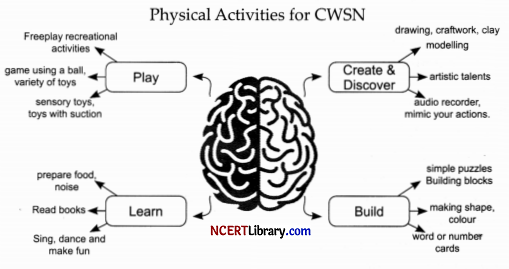
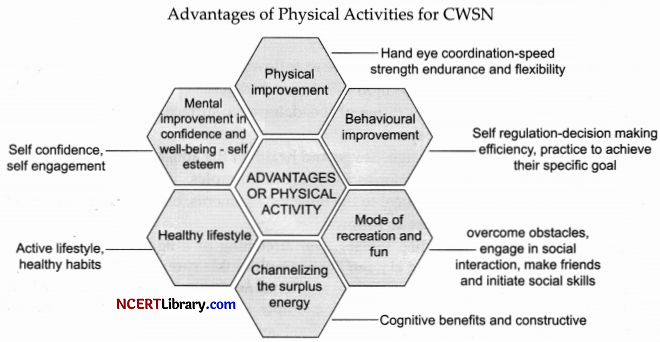
Question 26.
What are carbohydrates? Differentiate between its types. [l+(0.5×4)]
Answer:
Carbohydrates are the main source of energy in all activities. Carbohydrates are a class of organic compounds composed of carbon, hydrogen and oxygen. Carbohydrates are obtained from wheat, rice, maize, potato, com, banana, sugar cane, sweets, chocolates, bread etc. There are two types of carbohydrates, i.e., simple carbohydrates and complex carbohydrates.
(i) Simple carbohydrates: Glucose, Fructose, Galactose, Sucrose, Maltose and Lactose are called simple carbohydrates. These carbohydrates are soluble in water. These are crystalline and sweet in taste and are called sugar
(ii) Complex carbohydrates: Starch, Dextrin, Glycogen and Cellulose are called complex carbohydrates or polysaccharides. These are not sweet in taste. They are insoluble in water. They are not crystalline. The main difference between the types of carbohydrates is the difference between their chemical compositions. Simple carbohydrates have a smaller chain of chemical composition in comparison to the complex ones
Question 27.
Define bye. Explain the rules of giving bye with help of an example.[1+2]
Answer:
A bye means that a team does not have to participate in the first round of the tournament, but instead gets a free pass or advances to the second round.
Example:
3 Teams = 4 minus 3 (1 bye)
5 Teams = 8 minus 5 (3 byes)
9 Teams = 16 minus 9 (7 byes)
20 Teams = 32 minus 20 (12 byes)
Example Knock out fixture for 19 teams
Total number of Byes
= Next power of two- Total Teams
= 32-19 = 13 byes
\(Number of teams in upper half
=\frac{(\mathrm{N}+1)}{2}=\frac{(19+1)}{2}=10 \text { Teams }
\)
=\frac{(\mathrm{N}-1)}{2}=\frac{(19-1)}{2}=9 \text { Teams }
\)
Byes are always awarded in just the first round of the tournament. Byes should be allotted in the fixture in the following ways:
(i) the First bye should be given to the last team of Lower Half,
(ii) the Second bye should be given to the first team of the Upper Half,
(iii) the Third bye should be given to the first team of Lower Half,
(iv) the Fourth bye should be given to the last team of Upper Half,
(v) Same order should be followed after the fourth bye till the remaining byes have been given.
Question 28.
Make a table explaining any three personalities from Big five theory and their characteristics. [1+1+1]
Answer:
The five traits in the Big five theory are dimensional where each of the traits describes a range between two extreme poles. In spite of the differences based on age, gender or culture, every individual shares the same basic personality traits as well as differs on each of the traits also.
| Trait | Description |
| Openness | Being curious, original, intellectual, creative, and open to new ideas. |
| Conscientiousness | Being organized, systematic, punctual, achievement- oriented, and dependable. |
| Extraversion | Being outgoing, talkative, sociable, and enjoying social situations. |
| Agreeableness | Being affable, tolerant, sensitive, trusting, kind, and warm. |
| Neuroticism | Being anxious, irritable, temperamental, and moody. |
Question 29.
Explain any three physiological factors determining strength.[1+1+1]
Answer:
Strength is the ability to overcome resistance or to act against resistance. The strength of an individual is determined by the various physiological factors as discussed below.
(i) Muscle size : The size of the muscle is largely responsible to its strength of the muscle. It is an acknowledged fact that more force can be produced by bigger and larger muscles.
(ii) Body weight : Body weight determines the strength of an individual as well. It is known that heavier individuals are stronger in comparison to the lighter individuals.
(iii) Muscle composition: It can be said that the proportion of the fibers determines the strength. The fast twitch fibers produce more force as they can contract faster. The muscles which can produce more strength have more percentage of fast twitch fibers.
![]()
Question 30.
What is the meaning of the female athletes’ Triad? Explain any two in brief.[1+2]
Answer:
A female athlete who focuses on being thin or lightweight may eat too little or exercise too much. Doing this can cause long-term damage to health or it can also hurt athletic performance or make it necessary to limit or stop exercise. Three interrelated illnesses may develop when a girl or young woman goes to extremes in dieting or exercise. Together, these conditions are known as the “Female Athlete Triad.”
The three conditions are:
(i) Triad Factor 1: Disordered Eating Most girls with female athlete triad try to lose weight as a way to improve their athletic performance.
The disordered eating that accompanies the female athlete triad can range from not eating enough calories to keep up with energy demands to avoiding certain types of food the athlete thinks are “bad” (such as foods containing fat) to serious eating disorders like anorexia nervosa or bulimia nervosa.
(ii) Triad Factor 2: Amenorrhea Exercising intensely and not eating enough calories can lead to a decrease in hormones that help regulate the menstrual cycle. As a result, a girl’s periods may become irregular or stop altogether. Of course, it’s normal for teens to occasionally miss periods, especially in the first year. A missed period does not automatically mean a female athlete triad.
It could mean something else is going on, like pregnancy or a medical condition. Some girls who participate intensively in sports may never even get their first period because they
have been training so hard. Others may have had periods, but once they increase their training and change their eating habits, their periods may stop
Section -D
Question 31
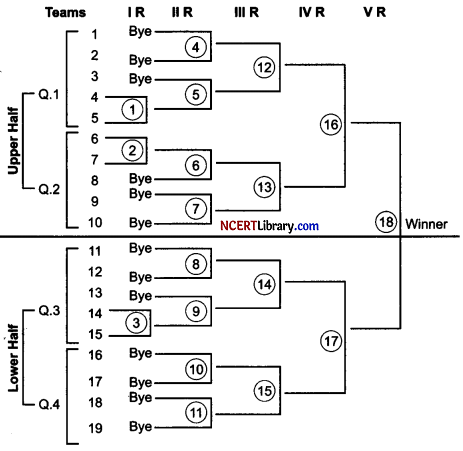
On the basis of the above-given fixture answer the following questions:
(a) Total number of matches in 2nd round are__________.
(b) What is the formula for calculating the total number of matches?
(c) The fourth round in this case can also be called as__________.
(d) What is the formula for calculating the number of byes?
OR
The formula for calculating the number of rounds is__________.
Answer:
(a) 8
(b) N-l
(c) Semi final
(d) 2n-N
OR
Answer:
2n i.e. power of 2,2x2x2x2x2
Question 32.
The teachers as well as coaches always make their best efforts to improve the performance of their students in various competitive games and sports. They can help to improve the performance of students if they have adequate knowledge of biomechanics. [4×1=4]
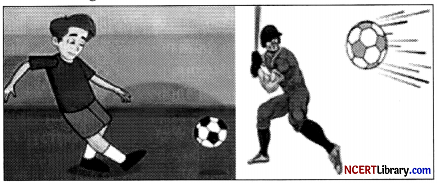
(a) The more force one exerts on the downward bounce, the higher the ball bounces into the air. Which law is this statement being referred to?
(b) Among the above given pictures, Newton’s 3rd law is depicted in___________.
(c) Newton’s second law is also known as_______.
(d) The study of human body and various forces acting on it is_______.
OR
A high jumper can jump higher off a solid surface because it opposes his or her body with as much force as he or she is able to generate. This example refers to which law of motion?
Answer:
(a) Newton’s Third law of motion-Action and reaction
(b) the First picture
(c) Law of acceleration
(d) Biomechanics
OR
Newton’s Third law of motion – Action and reaction
![]()
Question 33.
In relation to the pictures, answer the following questions.[4×1=4]

(a) What is the mission of the first organization?
(b) What is the Motto of the first organization?
(c) Until 1965 the games in the second picture were known as
(d) Second picture games are conducted after every_________.years.
Answer:
(a) The mission of Special Olympics is to provide year-round sports training and athletic competition in a variety of Olympic-type sports for children and adults with intellectual disabilities, giving them continuing opportunities to develop physical fitness, demonstrate courage, experience joy and participate in a sharing of gifts, skills and friendship with their families, other Special Olympics athletes and the community.
(b) “Let me win. But if I cannot win, let me be brave in the attempt.”
(c) Officially, the games were originally called the “International Games for the Deaf” from 1924 to 1965, but were sometimes also referred to as the “International Silent Games”.
(d) The Deaflympics are held every four years.
Section-E
Question 34.
List down any four asanas used for the prevention of asthma. Explain the procedure for administration of any one of them with help of a stick diagram.[2+2+1]
Answer:
Asthma is a condition in which the airways become narrow, get swollen and produces extra mucus. Asthma makes breathing difficult and produces coughing and breathlessness. Four asanas used for
the prevention of asthma are as follows.
1. Sukhasan
2. Chakrasan
3. Gomukhasan
4. Bhujangasan
Bhujangasan
![]()
Bhujanga means cobra in Sanskrit. This asana is known as Bhujangasana because its final position of it gives the appearance of a hooded snake under irritation with its neck dilated like a hood.
Procedure of Bhujangasana:
(i) ‘ Lie down on stomach with the legs straight, feet together and the soles of the feet uppermost.
(ii) Place the palms on the floor with the hands flat, by the side of the shoulders keeping the fingers together and pointing forward.
(iii) The arms should be placed close to the sides of the body in such a position so that the elbows point backward.
(iv) Place the forehead on the floor and keep the eyes closed.
(v) The whole body should be relaxed particularly the lower back.
(vi) Gradually raise the head.
(vii) Smoothly lean the head backward in a way that the chin points forward compressing the back of the neck and subsequently raise the neck followed by the shoulders.
(viii)With the help of the back muscle straighten the elbows first and progressively the arm muscles to raise the trunk further to create an arch in the back
(ix) The pubic bone remains in contact with the floor in the final position and the navel gets raised to a maximum of 3 cm.
(x) In case the navel is raised too high the curve is created in the knees and not in the back.
(xi) Depending on the flexibility of the back, the arms may or may not be kept straight.
(xii) Maintain the final position.
(xiii)In order to return to the straight position gradually release the upper back by bending the arms, lowering the navel, chest, and shoulders, and as a final point touching the forehead to the floor.
Benefits of Bhujangasana:
(i) In Bhujangasana, the spine receives a good backward stretch. Each vertebra is pulled back and provided with rich blood supply. The nerves and muscles or the spine are rejuvenated.
(ii) This asana also gives a stretch to the upper back (thoracic vertebrae), opens the chest and increases the lung capacity. It is also helpful to relieve chronic asthma problems.
(iii) This asana decreases the stiffness of the lower back and increases flexibility.
(iv) It strengthens the arms and shoulders. It tones the buttock muscles.
(v) It promotes a more smooth flow of prana (life energy) within the body.
Contraindication of Bhujangasana:
(i) People should not practice Bhujangasana with severe problems of the spine, stomach ulcers and hernia.
(ii) This asana should be practiced with care for those with stiff backs and for those who are menstruating.
(iii) It is also not recommended for people with heart disease. Should not be practiced by those who have undergone surgeries of the spine, brain, abdomen, heart and lungs.
(iv) During pregnancy and menstruation, women should avoid the practice of this asana.
![]()
Question 35.
Make a table of test items listed under fitness test by SAI (Age group 9-18 yrs ) along with the objectives of conducting them. Explain the administration of any one of them. [4+1]
Answer:
Test items listed under fitness test by SAI (Age group 9-18 yrs)
| Sr. No. | Test items | Objectives |
| 1. | Weight/Height2 | To find the Body mass index ‘ |
| 2. | 50mts dash standing start | To measure the speed |
| 3. | 600mts Run/Walk | To measure endurance |
| 4. | Sit and Reach | To measure flexibility |
| 5. | Partial Curl up30 Secs | To measure core, and abdominal strength endurance |
| 6. | Push-ups for boys Modified Push-ups for girls | To measure muscular endurance |
50mts Dash Standing Start
Purpose
The aim of this test is to determine acceleration and speed.
Equipment Required
Measuring tape or marked track, stopwatch, cone markers, flat and clear surface of at least 60 meters.
Procedure
The test involves running a single maximum sprint over 50 meters with the time recorded. A thorough warm-up should be given, including some practice starts and accelerations. Start from a stationary standing position (hands cannot touch the ground), with one foot in front of the other. The front foot must be behind the starting line.
Once the subject is ready and motionless, the starter gives the instructions “Set” then “Go”. On receiving the instruction “Go” the participant has to start sprinting. Scoring The time taken to cover 50 meters is recorded to the nearest two decimal places. The timing starts from the first movement (if using a stopwatch) or when the timing system is triggered and finishes when the chest crosses the finish line and/or the finishing timing gate is triggered.
Question 36.
Define flexibility along with its types. Explain any two methods used to develop flexibility.
Answer:
Flexibility is the ability to perform a joint action through a range of movements. Flexibility is coined as the capability to perform movements with superior range or amplitude. In other way, through a maximum range of motion. There are mainly two types of flexibility i.e.-, passive flexibility and active flexibility.
(i) Passive flexibility: Passive flexibility is the ability to do movements with greater amplitude by means of external assistance, e.g. With the help of partner doing a stretching exercise.
(ii) Active flexibility: Active flexibility is the ability to perform the movement without external help. E.g. The sportsman himself stretches a joint with no external help. There are two types of active flexibility i.e., static flexibility and dynamic flexibility.
(a) Static flexibility: While the sportsman is standing, lying, stretching and sitting in a stable position.
(b) Dynamic flexibility: It is done when the sportsman is moving with superior amplitude while performing a movement. Two methods used to develop flexibility are the Ballistic Method and the Slow Stretch and Hold Method.
(i) Ballistic method: This method means stretching movement is done with a swing. It means a joint is expanded steadily to its utmost range. It is one of the oldest methods of doing stretching exercises.
(ii) Slow stretch and hold method: By the given name of this method we can comprehend the meaning of the slow stretch and hold method. It means before going back to the original position, the joint is gradually stretched to the maximum limit and held there for 3-8 seconds. It has been found to be very effective for improving passive flexibility which forms the basis of active flexibility.
![]()
Question 37.
Define Projectile and explain any two factors affecting projectile with help of examples from sports.[1+4]
Answer:
“A body projected in to the air with a certain velocity inclined at an angle with the horizontal is usually termed as a projectile.”
Factors affecting projectile trajectory There are three parameters, in addition to gravitational acceleration, air resistance and spin that determine the trajectory of a simple projectile, such as a ball, shot or hammer.
These are the projection angle, speed, and height. The steepness or shallowness of the curve will depend on the angle of projection, with angles greater than 45 degree producing steeper curves and angles less than 45 degrees producing shallower curves.
(i) Projection Angle: The projection angle is defined as the angle between the projectile’s velocity vector and the horizontal at the instant of release or take-off. Hence the terms release angle or take-off angle are often used.
The size of the projection angle depends on the purpose of the activity. For example, activities requiring maximum horizontal range (shot put, long jump, ski jump) tend to use smaller angles than those in which maximum height is an objective (high jump). The optimum angle for a maximum horizontal distance of flight is 45 degrees, but there are factors in sports that mean that 45 degrees is rarely the optimum for maximum horizontal distance.
In the high jump, the optimum angle is in the range of 40 to 48 degrees, where the primary mechanical purpose is maximum horizontal distance the take-off angles are in the range of 18 degrees to 27 degrees. In the long jump, for example, take-off angles used by elite long jumpers are around 20 degrees.
(ii) Projection speed: For a given angle projection speed at release will determine both the height and the horizontal distance of the trajectory of the object or body. It is defined as the magnitude of the projectile’s velocity vector at the instant of release or take-off.
When the projection angle and height are held constant, the projection speed will determine the magnitude of a projectile’s maximum vertical displacement (its apex) and its range (maximum horizontal displacement). The greater the projection speed, the greater the apex and rang